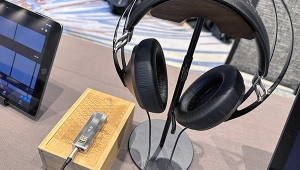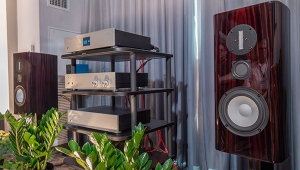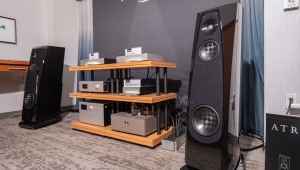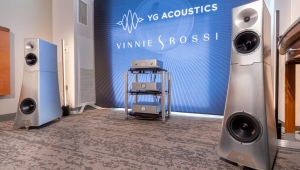| Columns Retired Columns & Blogs |
Arcam Solo CD receiver
Here we are, back to the Arcam I know and love: a company that not only invents good products, but good product categories as well. Like the Arcam Black Box of the 1980s, which gave so many people fits at the time—yet which, once you heard it, made good musical sense. It made good marketing sense, too: With that one stroke, teensy, weird, nestled-away-in-the-English-countryside Arcam did nothing less than create the domestic market for outboard digital-to-analog converters.
Footnote 1: It would have been feasible, but arguably too expensive, for the Arcam Solo to contain one of the proprietary chipsets for the two S-band digital broadcast schemes that Americans do have access to: the subscription-only Sirius and XM services.

Are they poised to do the same thing all over again? I don't know. But it's worth noting that Arcam's new Solo is the rare audiophile product that swims with, rather than against, the flow of mainstream consumerism—toward simplicity, convergence, and relative smallness. Now you can have a mobile phone that doubles as a camera, a laptop computer that doubles as a movie player—and a perfectionist-quality integrated amplifier that doubles as a CD player and a tuner. All for $1600, which is not very much money as those things go.
Deadbeat DABs
There's another story here: The Solo is the rare Arcam product that was designed more with Europeans in mind than Americans, the most telling sign of which is its inclusion of a DAB tuner. As you may already know, DAB, or Digital Audio Broadcasting, is a new consumer technology now available in Europe, Canada, South Africa, South Korea, and other outposts of civilization. In all the places that have it, DAB is governed by a set of technical and political standards known collectively as Eureka 147, arguably the most significant of which is the setting aside of two bands of DAB frequencies, separate from those used for present-day AM and FM broadcasts. But the US, which has rejected Eureka 147 altogether, seems bent on adopting standards that call for technically inferior in-band digital FM broadcasting.
The upshot of all that is a bit of sad news: While more than 200 million of our friends in Dublin, Budapest, Johannesburg, and elsewhere are already using their Arcams and other DAB receivers to enjoy fade-free, interference-free, multipath-free broadcasts, usually with enhanced programming content and a text feed that tells the listener what in God's name each speaker on their government's parliamentary channel happens to be prattling away about at the moment (seriously), I cannot comment on the Arcam Solo's DAB performance in this review: Whenever I pushed the DAB button on the Solo's remote handset, only silence ensued.
Then I noticed that my sample of the Solo came packed with a one-sheet disclaimer, which boiled down to this: If in the course of using your Arcam Solo in the US you should happen to press the DAB button by mistake, you will hear dick-all. Thank you.
But Americans have not been forgotten altogether. For one thing, I'm told that subsequent production runs of US-bound Arcam Solos will have an AM/FM board in place of the DAB/FM board that everyone else is getting (footnote 1). For another thing...well, what civilized person wouldn't want a beautifully styled product that turns CDs or radio waves into music for just $1600, plus speakers?
And the Solo is nothing if not stylish. My first thought upon opening the box was: If Apple made amps and CD players, this is what they'd look like. This is what they'd feel like, too, right down to the Audi-esque curves of the cast-alloy front panel and the decidedly noncheap feel of the soft-touch buttons. The Arcam Solo was also one of the most ergonomically intuitive products I've reviewed: I don't know why, but without having to look at the sparsely labeled controls I simply knew that the button to the left of the slim CD drawer was for eject, the one to the right was for play, and the pair on the far right were for volume up and down. (And you thought they were for cutting the capital gains tax!)
At a little over 17 lbs, the Arcam Solo is a lot heavier than the average budget component—and I discovered why when I removed its perforated, satin-finish cover: Beyond the cast-alloy faceplate, the Solo gets its heft from a pair of toroidal transformers and a robust amplifier output section, built around a heatsink that's well finished and downright massive for the price. The line stage, power amp, and most of the power-supply circuitry all reside on a fairly large L-shaped board, while the CD player, tuner, digital control circuitry, and power-supply relays all have separate boards of their own. Build quality and attention to detail are all superb—one nice touch I'd never encountered before is the use of tube-style damping rings on all of the (Rubycon) reservoir caps—and the individual components have good pedigrees, including a Sony disc transport and a DAB module by Radioscape, the tiny English company that makes the DAB modules for Sony's new car radios.
In an apparent nod to audio newbies—the fine owner's manual actually includes the words In order to hear any sound from Solo, you must connect speakers to it2—the Arcam Solo is a breeze to install. Rugged speaker connectors allow spade terminals, banana plugs, or bare wire, and there's an RS-232 input for those who wish to let their computers boss their audio systems around. There are gold-plated phono jacks on the back for a tape loop, plus three pairs of line-level inputs (labeled AV, TV, and Game on the remote handset) and an iPod minijack input on the front (labeled Front). There's also a threaded F-style connector on the back, so broadcast enthusiasts can easily connect a flexible dipole, which is included, or some other outboard antenna.
Another nice feature, which I imagine will strike a chord with nonaudiophiles, is the inclusion of a pair of Zone 2 preamp-out jacks: These can be used to drive a separate power amplifier in another room, the volume of which can be adjusted, or muted altogether, separately from the main pair, using the remote handset. Neat.
In typical contemporary fashion, only the most basic user controls are available on the front panel, while the attractive handset offers the whole gamut. Volume, balance, and even treble and bass (!) were easy to adjust, and tuning and storing FM stations was simplicity itself. There's an alarm clock function, too, something lacked by my first integrated amplifier. Come to think of it, none of my amplifiers has ever had an alarm clock.
Solo performance
So you can imagine how surprised I was that the Solo sounded decent. Very decent, in fact. Even straight out of the box, before being run in or warmed up—during which time it sounded gray and uncomfortable, the sonic equivalent of a new shirt whose seams are a bit conspicuous—the Solo was musically capable and expressive. I hooked it up to my big Quad speakers, put on the Eroica Quartet's recording of Mendelssohn's String Quartets 1, 2, and Op. Post. (Harmonia Mundi HMU 907245), and thought: This would impress almost anyone.
And it got better within minutes. Minutes, I tell you.
I moved on to the wistful "One in a Hundred," a Byrds song in all but name that wound up on the Gene Clark solo collection Roadmaster (CD, Edsel EDCD198). Notwithstanding the jangly-broad tempo, the song moved along smartly, and all the instruments had the right sparkle and color. "One in a Hundred" isn't a terribly good recording, and Roger McGuinn's electric 12-string guitar part in particular can sound glassy through some gear—but not here. It was simply fine, musically and sonically. And on the wonderful Let My Burden Be, by Golden Shoulders (CD, Doppler dr1102), Adam Kline's nicely recorded voice sounded present and believable, while the album's many catchy arrangemental touches—the percussion sounds on "Do You Know Who You Are," the cool, thick slide guitar on "Spirit of '78," the piano part on "Overhead Underground"—popped out of the mix and grabbed my attention without being bright about it.

JVC's pleasant XRCD remastering of Fritz Reiner's last recording of Strauss's Also sprach Zarathustra (CD, JMCXR-0011) was nicely served by the Solo in all the essential ways. The organ pedals and kettledrums in the Dawn and Of the great longing sections had good clarity and pitch definition, the Solo showing no sign of difficulty in damping the Quads' panels. Those instruments also had decent, if not peerless, weight and scale, and the piece as a whole flowed from beginning to end: not bad for digital. I might have asked for more color and texture in the strings, and with so much going on in one product it's hard to say what portion or portions of the Solo could be made better in that sense—but the sound was by no means poor, and the musical message wasn't at all compromised.
At the other end of the spectrum, the Arcam Solo sounded good on Simon and Garfunkel's Live from New York City, 1967 (CD, Columbia/Legacy CK 61513), an album that's grown on me since its release in 2002 (although I still think they should have played "The Dangling Conversation" for laughs). Everything in this generally spacious recording sounded a little more forward than usual through the Solo, but not to the point of distraction—and vocal sibilants and subtle hall reflections alike were preserved and presented without sounding etched or unreal.
With the help of a borrowed Linn Linto phono preamp, I also tried some LPs with the Arcam Solo, and for some reason found myself focusing on Columbia's other icon of the 1960s, Leonard Bernstein. His Brahms Third of 1964 (LP, Columbia D3M 32097) isn't the best one out there, but it's one of only two I have on vinyl, and it's good enough to get the job done in a pinch. The Arcam responded to the challenge by delivering a pleasantly explicit performance: The different woodwinds were distinct from one another, and bowings in the string sections were easy to discern. Of even greater importance, the Solo was at least pacey enough to give Bernstein's quick, snappy way with some lines their due: Laggy or thick this was not.
It was also not as rich, solid, or whole-sounding as with the electronics I already own and use; but then again, if purchased at retail, my Fi preamp and EAR amp together would push the price into the five-figure range. Spoiled aesthete that I am, I can't help but note the Solo's relative shortcomings; on the other hand, no one can dispute that the Arcam, which costs less than one-sixth the price, delivered a great deal more than one-sixth the music. And an alarm clock, too.
Before wrapping up, I made a point of comparing the sound of Arcam's own CD section to that of Naim Audio's CD5x—which, at $2900, is itself regarded as a "budget" product, albeit in a somewhat different sense—driving the Solo's AV inputs. The multibit Naim did sound bolder, more dramatic, and altogether more real. But the Solo's player, which uses a Wolfson Microelectronics 24-bit sigma-delta DAC, was competitive in every way, with unambiguously refined sonics and a consistently involving musical performance. For whatever reason, dimly or not, I admit having thought of the Arcam Solo as an integrated amp with a CD player thrown in; after that comparison, I tended to think of it as a CD player that also happened to do a good job of driving loudspeakers.
A few words about broadcast music: The Arcam Solo's FM tuner carries a sensitivity spec of 2µV—a good rating, regardless of how it was arrived at (mono, stereo, whatever). But in my rural setting, using the aforementioned dipole antenna, the Solo's real-world sensitivity appeared to be just average: The Tivoli Model One was cleaner and surer with stations that escaped the Arcam's grasp. Adding the RadioShack 15-2163 FM antenna to the mix brought the Arcam's performance up to par, of course, so if you buy a Solo with the intention of relying on FM broadcasts for a major portion of your listening, do please consider buying a good, unamplified antenna. By the way, in reminding me that I'd once recommended Syracuse's fine classical music station WCNY (heard at 89.5 in Utica, which is nearer to where I live), my friend the excellent banjoist Doug Yaehrling (formerly with John Rossbach and Chestnut Grove) pointed out that the station has a Bluegrass Ramble every Sunday night from 9pm until midnight. Fellow upstaters, take note.
Solo summing up
At the end of the day, the most remarkable thing was that the Arcam Solo had me looking back over my shoulder at the past quarter-century of progress in domestic audio. It made me recall how, when I first got involved in this hobby, I marveled at the enormous difference in performance between affordable, mass-produced gear and the perfectionist stuff that captured my attention. I remember predicting, or at least hoping, that the often overpriced, unreliable, poorly packaged, but wonderful-sounding equipment of the early 1980s and beyond would exert enough of a positive influence on the rank and file among subsequent generations of engineers that truly good performance would someday be commonplace in products that would also be fairly priced, reliable, and cleverly packaged—which is to say, products that average people could not only obtain but that they might actually want to obtain. The Arcam Solo is among the first significant steps along that road. Strongly recommended.
Footnote 1: It would have been feasible, but arguably too expensive, for the Arcam Solo to contain one of the proprietary chipsets for the two S-band digital broadcast schemes that Americans do have access to: the subscription-only Sirius and XM services.
Footnote 2: Later this year Arcam will launch the Alto, a small loudspeaker designed specifically for use with the Solo.
- Log in or register to post comments



































